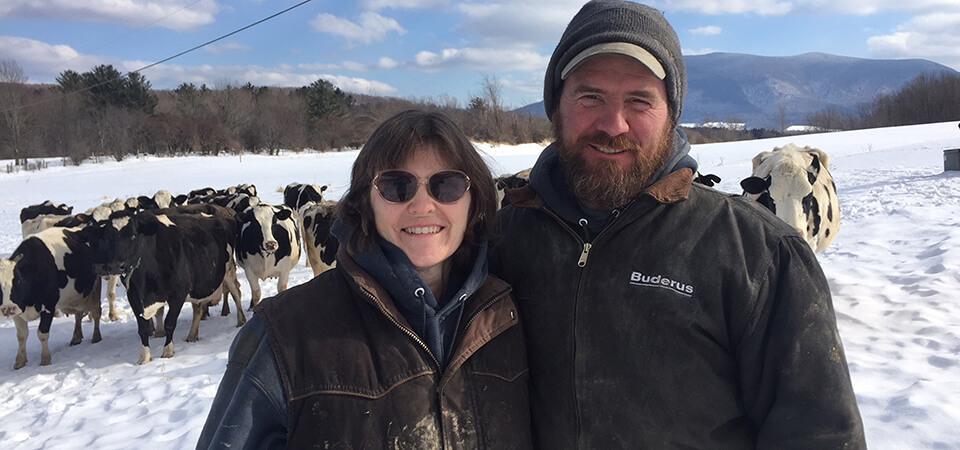One of the highlights of my job as a grazing specialist for the University of Vermont (UVM) Extension Champlain Valley Crop, Soil and Pasture Team is seeing how farmers adopt new practices and evolve with them over time. Seeing the success stories on the ground is very inspiring.
I first met Hilda Fisk Haines and Steve Haines in early summer 2013. Hilda and Steve operate the Fisk-Haines Farm in Danby, Vermont, which Hilda's father originally purchased in 1951. They milk 80 Holstein cows, shipping their milk through Dairy Farmers of America, and manage approximately 250 acres.
For that first visit, now six years ago, they wanted to discuss some ideas on rotational grazing with which they had begun experimenting. They were moving cows between a handful of pasture areas covering about 20 acres.
Looking back Hilda says, "I did not understand the logistics. I was doing it on a wing and a prayer."
Each year I would check in and each year Hilda was adding more acres and more paddocks into the rotation. By doing this, she was able to increase the recovery time for her pastures to grow back and increase their dry matter yields.
By the 2018 grazing season, the Fisk-Haines Farm had 60 acres incorporated into the pasture rotation. When I drove to the farm late last summer, I was excited to see temporary polywire fencing around many of their hayfields.
"The polywire fence I can do myself and run it the way I want, changing the paddocks mid-season," Hilda explains. "I love the flexibility of the poly."
Before the 2018 grazing season began, Hilda participated in UVM Extension's four-part grazing class where farmers not only learn in-depth grazing principles but also have a hand in developing their own plans. This program is part of a two-year Sustainable Agriculture and Research Education grant that combines classroom education with on-site consulting visits.
"In the pasture class I picked up stuff that made a difference this year," says Hilda. However, as far as implementation goes, it is her daily attention to both the plants and the animals that has been critical to her success.
While Hilda and Steve did invest in a water system in 2017, they said the payback was quick and worth it. It allowed them to bring water to more areas of the farm, increasing the ability to graze more acres and adding to the efficiency of the grazing system. Every investment they have made from new polywire fence to water pipe to frost seeding has been done independently without cost-share money.
"There hasn't been a year we haven't done something new," Hilda points out.
What has been their motivation to do all this?
"It's simple," Hilda says. "Money. This is the cheapest milk I've ever made."
By comparing their winter ration to their grazing season ration, it is easy to see why. From early May through October, Hilda and Steve are able to reduce their feed ration by 5,600 pounds of grain, 22,400 pounds of corn silage, and 8,400 pounds of haylage per week over at least a 24-week period, and in some years extending that up to 28 weeks as they gradually increase supplementation.
When the farmers and I put values on these feed sources, we estimate a savings of about $1,830 per week, or just under $44,000 over a 24-week period. Every additional week the cows graze into the fall will add to this total.
By comparing the winter and summer rations, we calculated that the cows obtained approximately 63 percent of their daily dry matter needs from pasture this past season and their milk production (averaging 70 pounds per cow per day) was maintained through it all.
"It has changed our breakeven point," Hilda notes. "If we hadn't done this, I don't think we could have withstood the price drop."
As far as animal health goes, the dairy farmer reports that her annual vet bill is now one third of what it had been in the past.
"Our animals are healthier. They breed back better, their feet are stronger," she says.
So what is next on the horizon?
Grazing cover crops. Although they are now planting 20 fewer acres of corn as a result of their improved grazing, Hilda figures if she grazes the winter rye cover crop on her cornfields, she can add an extra two weeks on the front end of her grazing season.
For this farm, that is an easy decision. It's money in the bank.
For more information, contact the UVM Extension Champlain Valley Crop, Soil and Pasture Team at cvcrops@uvm.edu or (802) 388-4969 or (800) 956-1125 (toll-free in Vermont).
